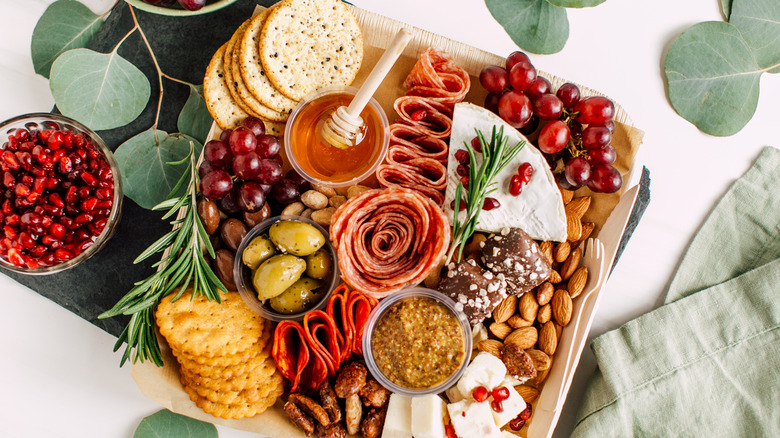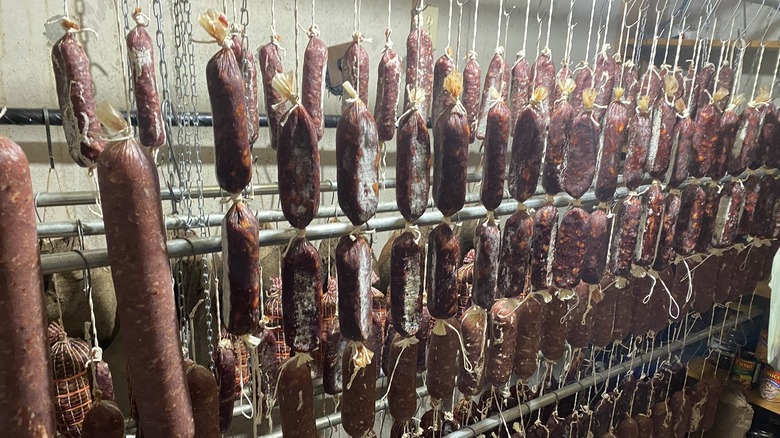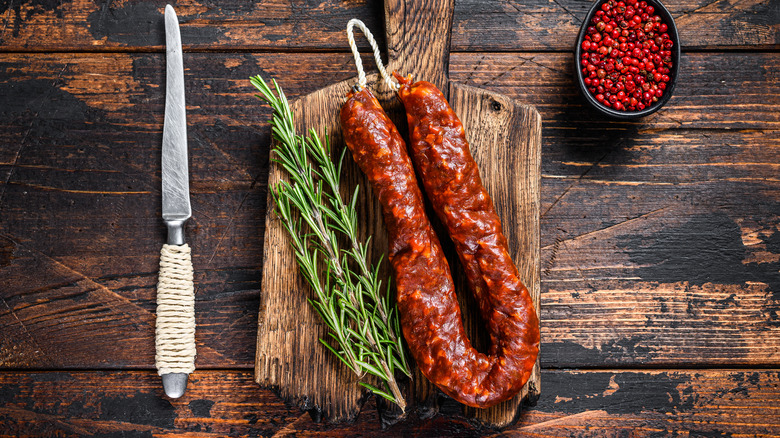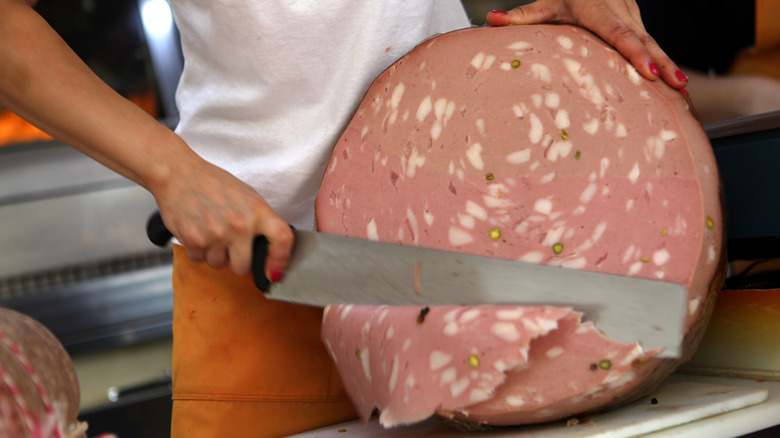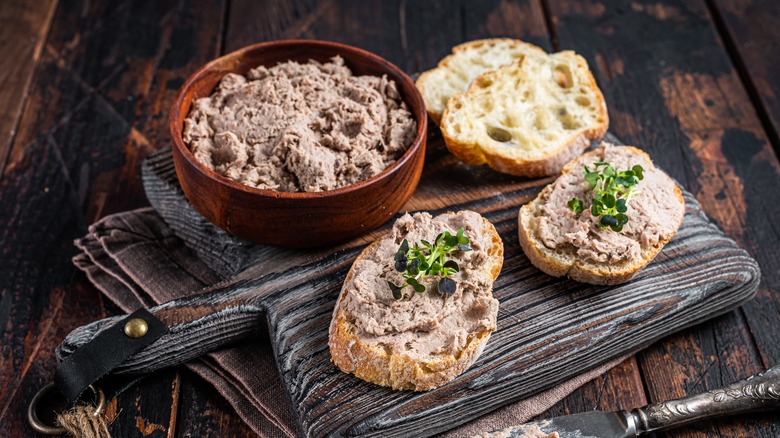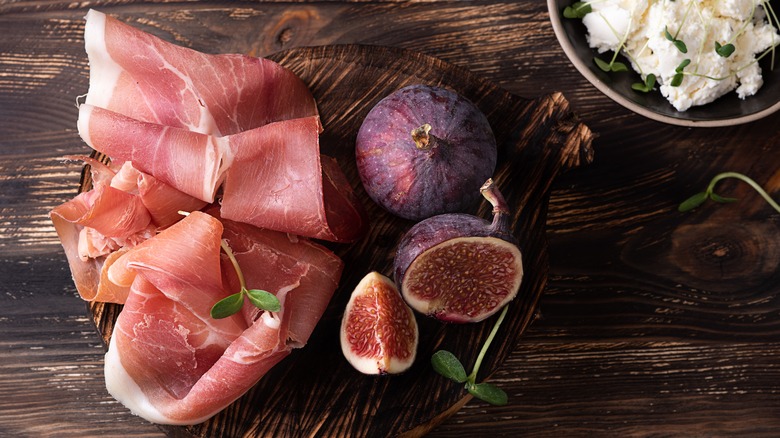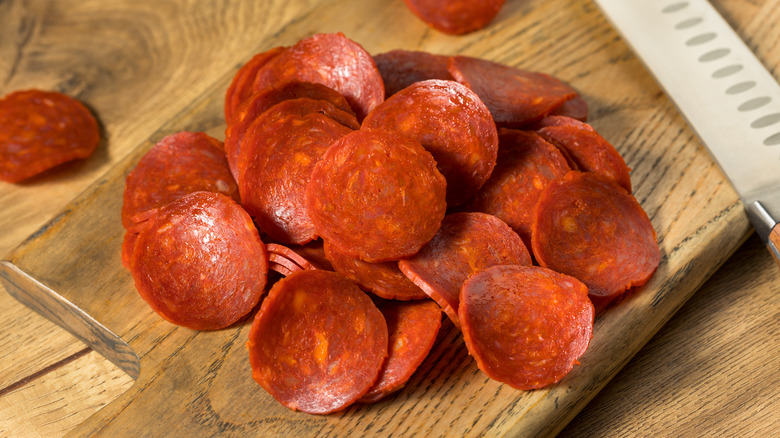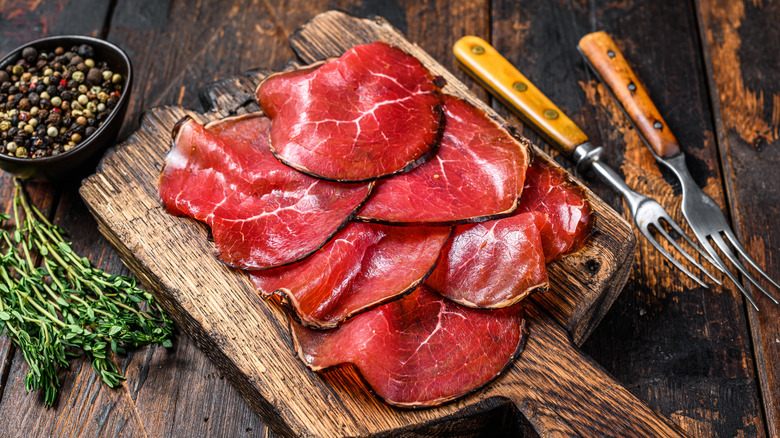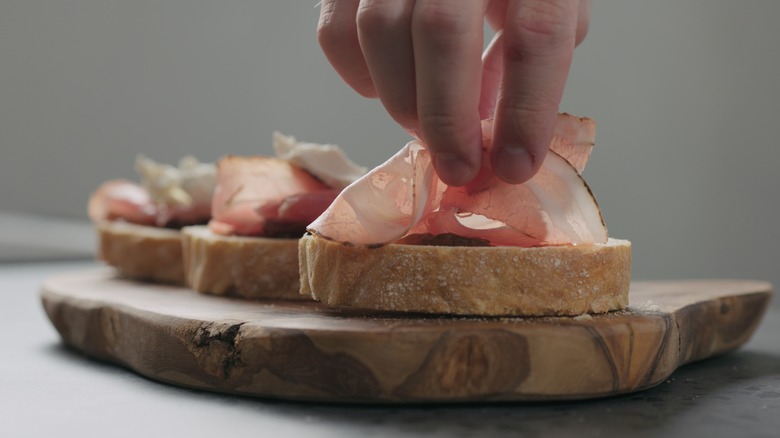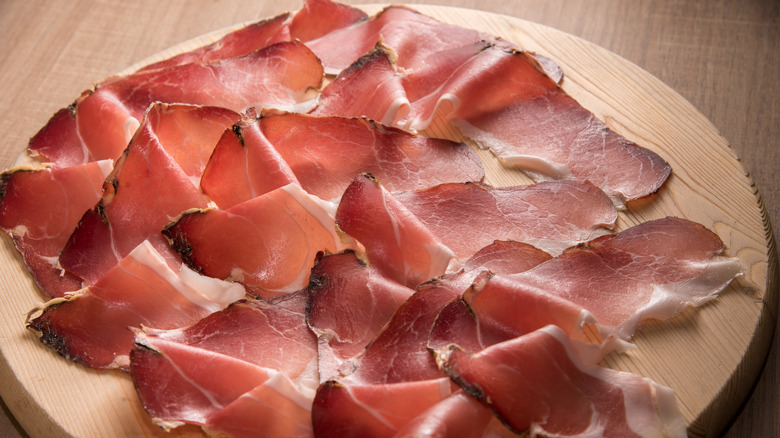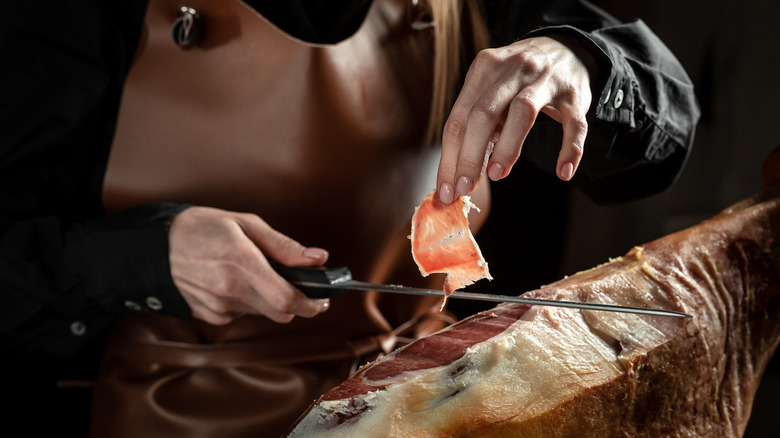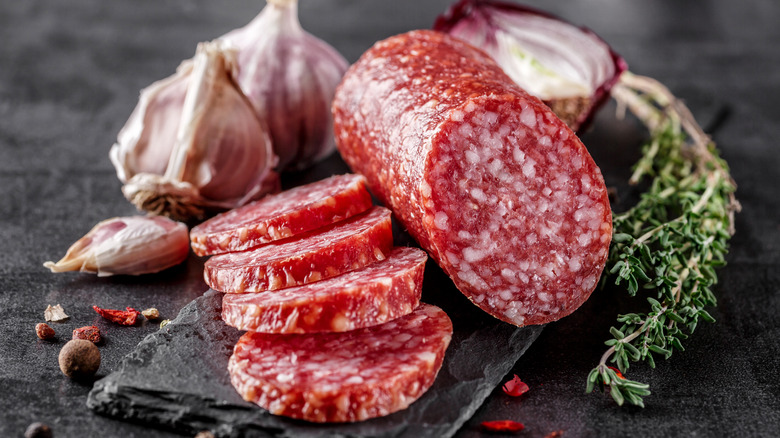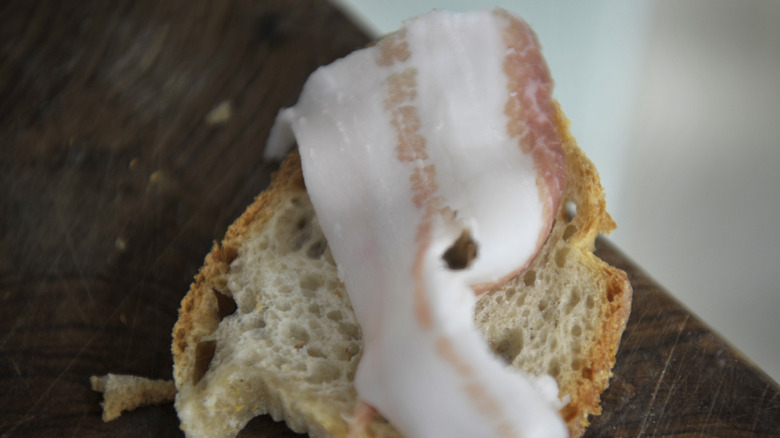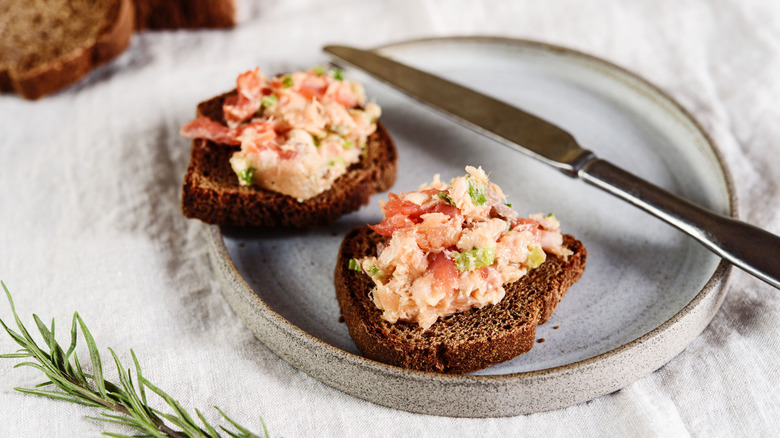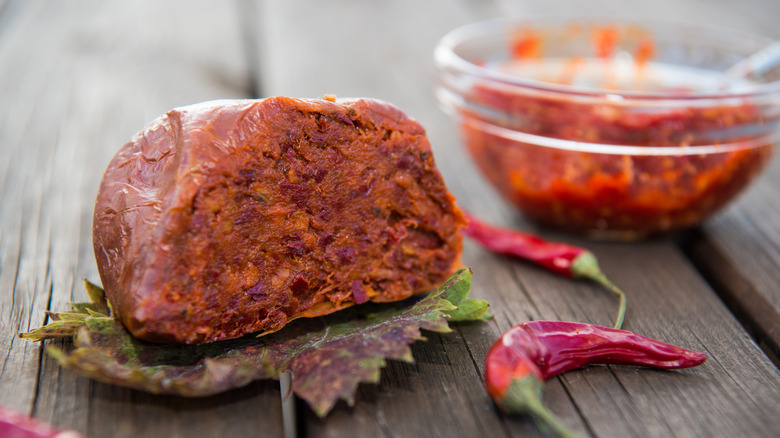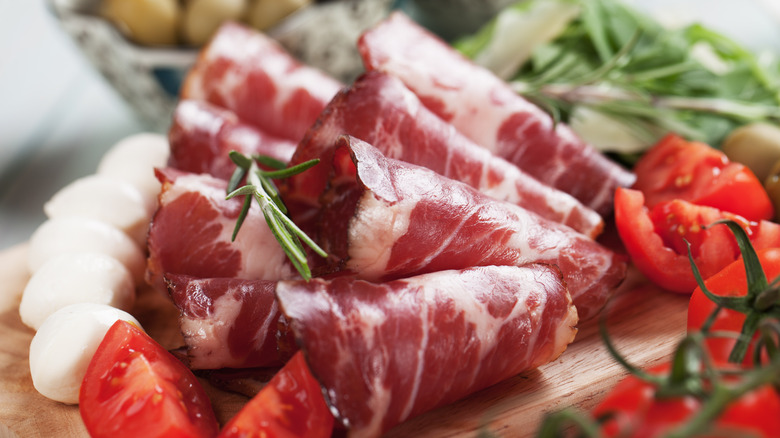15 Types Of Meat For Your Next Charcuterie Board
If you're looking for newfound inspiration and exciting additions for your charcuterie board, the options may seem endless. There are so many amazing items and ingredients you could potentially mix and match to create a one-of-a-kind, rave-worthy charcuterie board at home.
These boards and the various items that they usually feature, such as meats, cheeses, bread, crackers, dried fruit, nuts, and other accompaniments all combine to form a grazing experience that can be as enjoyable to look at as it is to eat.
The word "charcuterie" is literary derived from the French words "chair" and "cuite," which combine to mean "cooked flesh." So it makes sense that a delicious assortment of smoked and cured meats is a key component of smoked and cured meats.
However, considering all the smoked and cured meats you can find at an upscale grocery store, deli, or butcher shop, picking the right meats for your board can be challenging. After all, whichever meat you choose should suit your tastebuds and pair perfectly with the other components of the board as well as any accompanying drinks.
1. Soppressata
According to La Cucina Italiana, soppressata is a mildly spicy, cured pork product that is made from only the haunches, shoulders, and fillets of the pig. The pork is packed in natural casing, tied with string, and aged for around 40 days. This dense sausage is associated with several regions around Italy.
However, if you want to go for authenticity, you'll want to look for soppressata that's DOP-certified. As Eataly explains, DOP stands for "Denominazione d'Origine Protetta" or "Protected Designation of Origin" and this certification guarantees a product is traditionally and thoroughly produced, processed, and packaged only in the specific Italian region that is tied to the item's overall Italian heritage.
If you're looking for DOP-certified soppressata, it's best to opt for a soppressata that is produced in Calabria. Soppressata can be served with red wine, oil-packed vegetables, and aged cheeses.
If you're looking for a cheese that pairs well with this meat, look no further than the DOP-certified Caciocavallo Silano, which is made from raw cow's milk and aged by tying the cheeses together and hanging them across a beam (via Murgella).
2. Chorizo
Chorizo is a fairly recognizable addition to any charcuterie board. You may be familiar with this spicy pork sausage thanks to its place in Mexican and Spanish-inspired dishes such as tacos and paella as well as from the range of different restaurants that serve chorizo. If you plan to add chorizo to your charcuterie board, though, opt for the Spanish chorizo. Mexican chorizo is sold raw and requires cooking, while Spanish chorizo is already cooked and can be eaten immediately with its casings.
Spanish chorizo is made from rough-chopped pork and is on the fatty side and is filled with herbs such as Spanish paprika. Depending on the Spanish chorizo you buy, the sausage may be fermented or smoked, but it will always be cured. Look for a leaner type of Spanish chorizo for use on charcuterie boards and consider pairing your chorizo with an aged Spanish cheese like manchego. Castello Cheese notes manchego also goes well with other cheeses such as Parmigiano Reggiano and Pecorino Romano.
3. Mortadella
Mortadella is a cold cut that's sometimes referred to as the "bologna of Italy," but don't make the mistake of thinking that this meat is at all unrefined or belongs in your lunchbox alongside white bread and some mustard. Mortadella was once a food that was reserved only for Italy's elite (via Italy Magazine). Today, mortadella is commonly eaten in warm snacks, as a cold cut in various dishes, and/or plain, like on a charcuterie board.
This emulsified sausage is a mixture of meat and other ingredients, such as pistachios, myrtle berries, and black pepper. New Orleans' famed muffuletta sandwich contains mortadella.
According to Boston restaurant Mortadella Head, mortadella can be combined with other cheeses into an amazing antipasti platter. The platter can incorporate cheeses such as Pecorino Romano, mozzarella di bufala, and Taleggio. Other possible accompaniments include figs, pears, olives, and roasted red peppers. Mortadella can typically be found at Italian specialty stores and some delis.
4. Pâté
While most charcuterie board meats are dried sausages or thinly-sliced cold cuts, pâté stands apart as a spreadable, smooth, and admittedly somewhat fancy offering that's sure to impress your foodie friends. Pâté is made with organ meat (chicken liver is popular), herbs, and whatever binding ingredient your recipe calls for, such as milk, eggs, or bread.
Pâté does require cooking and chilling, so it is a little more labor-intensive than some of the other items you might add to your charcuterie board, which often just require a little slicing and arranging.
If you do decide to cook pâté for your next charcuterie board, according to Bon Appétit, the process is easier than you might think: The recipe requires chicken livers, garlic, onion, herbs, butter, red wine, and vinegar.
The hardest part of this process is cleaning the liver. Once this is done, the ingredients need to be cooked, run through a blender or food processor, and then chilled. If you're short on time, you can also buy ready maade pâté for a convenient addition to your charcuterie board.
5. Prosciutto
Prosciutto is an Italian deli meat that can be widely found in most grocery stores. It is widely available, making it an easy meat to add to your charcuterie board. Prosciutto can sometimes even be found in gas stations, near the refrigerated snacks. Prosciutto is made by coating a pig leg with salt and then allowing it to sit and cure for a lengthy amount of time, sometimes for multiple years.
Prosciutto can be paired with bright and summery fruit and mozzarella for the easiest-ever charcuterie spread, and the leftovers can even be enjoyed in sandwiches and salads. However, prosciutto is very high in sodium, which you'll likely realize as soon as you take a bite. Just a few slices of Boar's Head prosciutto contain nearly a third of your daily recommended sodium intake, in addition to nearly 10% of your daily recommended cholesterol and 3.5 grams of fat.
6. Pepperoni
Pepperoni isn't just for pizza. Skip over the bagged and sliced pepperoni you'll find in your grocery store's prepackaged deli section and go for a fancier grade of pepperoni for a delicious addition to your charcuterie board. Pair this pepperoni with your favorite crusty bread and some mozzarella for a wonderful lunch meal option.
Pepperoni was invented in the early 1900s by American Italian immigrants. It is made from a finely ground mixture of pork and beef in addition to spices like paprika and chili pepper, which can add a some much-needed zest to any charcuterie board that's suffering from an overabundance of milder flavors.
Pepperoni is also great for making meat roses to go on your charcuterie board, which can add some extra visual interest to your board (plus, they're just fun!). If you specifically want to make meat roses with your pepperoni, it's best to look for larger, more thickly-sliced pepperoni for easier sculpting.
7. Bresaola
Bresaola isn't very common on charcuterie boards, for two reasons: Its supply has been limited due to previous bans on the importation of the product and because it is relatively pricey.
According to Great Italian Food Trade, imported bresaola only became legal in the United States in 2014. It was banned due to its bovine origins and fears surrounding bovine spongiform encephalopathy, or, as it's colloquially known, mad cow disease.
However, this cured meat is totally legal now, and as True Italian asserts, it is one of the healthier Italian cured meats, as it's lower in fat than some other meat options. Additionally, it contains numerous minerals that make it nourishing and tasty.
Bresaola is made by air-drying salted beef for several months until the beef hardens and darkens. Often, the exterior of the meat is rubbed with spices such as rosemary, juniper, pepper, cinnamon, or cloves. Bresaola pairs well with Parmigiano Reggiano, olives, and nuts.
8. Pancetta
You may be more familiar with pancetta due to its inclusion in recipes for pasta dishes like carbonara; however, pancetta is also an excellent addition to your charcuterie board. While often compared to bacon and sold chopped and intended for cooking, pancetta is cured and, unlike bacon, does not require cooking. Instead, if you buy it sliced, you can simply arrange it on your charcuterie board straight from the packaging.
Pancetta is made by seasoning, curing, and drying pork belly, and often seasoning it with salt, spices, and sugar. The drying process can take up to a month. Due to the high amount of salt used in making pancetta, the meat has a naturally very salty flavor, along with hits of the spices used in the curing process such as bay, nutmeg, and thyme. You can find pancetta at most grocery stores or you can even make your own at home if you have the time to wait a few weeks for the pork belly to dry and cure.
9. Speck
According to Eataly, speck is a cured pork product that is similar to prosciutto; however, there are some key differences between the two: Traditionally, speck is made in the South Tyrol region of Italy. There are strict guidelines surrounding the pork used in speck that dictate where the pork is raised, what it's fed, and even how it's transported.
The pork legs that are used for making speck must never be frozen. The legs are rubbed with salt and spices and cooled, and then regularly turned for several weeks. The speck is then smoked outdoors, before being cured for approximately five months in a curing cellar. The result is a spicy, smoky, darker cousin of prosciutto.
Similar to prosciutto, speck can be served sliced on your charcuterie board. Speck can be paired with cheeses like Piave, which, according to Murray's Cheese, is a pasteurized cow's milk cheese that tastes similar to Parmigiano Reggiano as it is aged for a year and features fruity and bitter notes.
10. Jamón Ibérico
Iberico ham, or Jamón Ibérico, is a well-known Spanish cured ham that's similar to both prosciutto and speck in that it's also made by curing pork legs. However, unlike prosciutto, Ibérico is not quite as easy to find at your average discount grocery store and it's notoriously expensive.
The high cost of Jamón Ibérico is due to the impressive marbling and the fact that only so much Ibérico ham is produced at a time in very specific geographic areas. Other factors that drive up the price include the way the pork must be raised for this product: The livestock must be free-range and fed acorns and other scavenged items like berries and nuts.
Additionally, the pork must be harvested when the pigs are 15 months old. The pork legs should be salted for nearly three weeks, then aged for nearly a year, before being stored for up to four years. This lengthy process results in a high price tag (up to $4,500 for an entire pork leg, according to Insider) but the meat is a revered treat that will add some extra luxury to your charcuterie board.
11. Salami
If you decide to include salami on your charcuterie board then you have a lot of options to choose from. Salami is any Italian sausage that's been salt-cured, dried, cooked, or fermented. Salami may be made from a range of meats such as pork, beef, game, and other ingredients might include spices or wine.
The mixture is encased, dried, and, most often, fermented. Salmi is labeled either as cured or uncured; cured salami is preserved with salt and additives, while uncured salami is preserved using natural curing agents only. Pepperoni, for example, is a cured salami.
Various varieties of salami have different names (such as Sopressata or pepperoni) but don't make the mistake of mixing up salami and salumi. Salumi is a broader term that refers to Italian cured meats in general, including salami, as well as different Italian meats, such as prosciutto and pancetta, that are made using other methods.
12. Lardo
You might not immediately think of adding lardo to your charcuterie board, but it's worth giving this meat byproduct your consideration, especially if you're looking for something a little unique and unusual to add to your spread. Lardo is Italian, cured, pork back fat, and it is similar to lard in that regard. However, just because this item is made of fat, don't think that eating it is similar to biting down on a stick of butter.
Larde is salty, smoky, and seasoned, though it has an overall mild flavor. Lardo makes a delicious addition to a charcuterie board as an item that can be enjoyed with bread and crackers, similar to how you might enjoy a pâté.
Traditionally, lardo is made by brining the fat and then blending it with an array of spices like cinnamon, nutmeg, thyme, and oregano. After the brining process, the lardo may be hung to dry, depending on the manufacturer.
13. Rillettes
Rillettes are similar to pâté, in that they're a meat-based spread that can be served on a charcuterie board alongside bread or crackers. However, rillettes have a little bit more texture compared to a pâté. Additionally, unlike pâté, which is made from organ meat, rillettes are typically made of pork, making them a suitable alternative for people who don't enjoy organ meats.
However, it's worth noting that making rillettes does require a little more effort than cooking pâté. Rillettes are traditionally made by slow-cooking meat, like a pork shoulder or leg, over a long period of time and then shredding it by hand till you've achieved a fine texture which is then mixed with the meat's fat and cooking liquids (via Saveur). Rilllettes are like the shredded, decimated version of a confit. Rilllettes must be refrigerated before being brought back up to room temperature for serving.
14. 'Nduja
'Nduja is the Southern Italian version of a pâté. 'Nduja is essentially a spreadable salami that is made from pork and Calabrian chili peppers. Traditionally, 'nduja was made using pig scraps: All the leftover bits and pieces would be minced and encased in the pig's stomach. However, these days, 'nduja is usually made from more palatable pork bits, such as pork cheek, lard, and bacon, though this is not always the case.
The chili pepper is a necessary ingredient, not just for the color and flavor it brings, but also because it acts as a natural preservative. The ingredients are mashed until creamy and encased, and then smoked before a curing process that must be longer than three months but shorter than six months.
'Nduja makes a yummy spread for your charcuterie board's crackers and bread, especially when paired with mild, soft cheeses like burrata. And, you can use the leftover 'nduja in a variety of ways: It can liven up pizza and pasta thanks to its bold, spicy flavor.
15. Capicola
Italian cured meat capicola stands apart from other similar salumis specifically because of the area from which the pig originates. The pork used in capicola is always sourced from a pig's neck and shoulder area, specifically below the pig's neck and no lower than the fourth or fifth rib. Traditionally, the pig that is used to make capicola weighs at least 300 pounds and is at least eight months old.
Capicola is one of the oldest types of salumi available (at least compared to younger meats like pepperoni); it was enjoyed by the Greeks more than 2,500 years ago. Capicola is either cooked or dry-cured; you can even make your own at home if you're feeling ambitious.
You can serve capicola on your charcuterie board similarly to how you might serve prosciutto, alongside dried or fresh fruits, veggies, crackers, and cheese. However, it's worth noting the meat's flavor profile will differ from brand to brand. The flavor is also dependent on the spices that are used in the curing process, from coriander to chipotle powder.
